In one point not up to date anymore. The Redmi Note 12 Pro aims to set new standards in the midrange with a new camera sensor and optical image stabilization. In addition to the “flagship camera,” the new MediaTek Dimensity 1080 processor is also used. Find out here whether an upgrade from the Redmi 11 Pro is worthwhile.
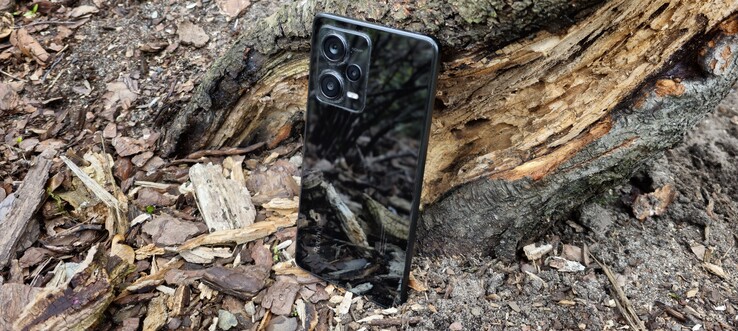
After the Redmi Note 10 Pro at the latest, the Note Pro series from Xiaomi stands for a powerful camera in combination with a very good display in the midrange. Thus it is not surprising that the Chinese manufacturer also targets these qualities with the Note 12 Pro.
The successor of the Note 11 Pro again offers a large and fast 6.67-inch 120-Hz 1,080p+ AMOLED display, but now you can also adjust the refresh rate to the contents. With Dolby Vision, HDR10+, and stereo speakers, media consumption is now also the focus of the Xiaomi smartphone. While the Note 10 Pro and Note 11 Pro used a 108-MP sensor from Samsung (ISOCELL HM2), Xiaomi now uses the Sony IMX766 with a resolution of 50 MP including OIS that we already know from the Xiaomi 12.
In Germany, the Redmi Note 12 Pro is available with 128 GB UFS 2.2 storage and optionally 6 (MSRP: 399 Euros, ~$439) or 8 GB LPDDR4X RAM (MSRP: 429 Euros, ~$472), but already a short time after the official sale’s start, prices start moving more toward the 300-Euro mark (~$330). At the time of this test, the 256-GB version of the MediaTek Dimensity 1080 smartphone is already available for about 350 Euros (~$385).
Display
6.67 inch 20:9, 2400 x 1080 pixel 395 PPI, capacitive touchscreen, OLED, glossy: yes, HDR, 120 Hz
Storage
128 GB UFS 2.2 Flash, 128 GB
, 108 GB free
Connections
1 USB 2.0, USB-C Power Delivery (PD), Audio Connections: 3.5 mm audio port, 1 Fingerprint Reader, NFC, Brightness Sensor, Sensors: accelerometer, gyroscope, proximity sensor, compass, OTG, IR blaster, Miracast
Networking
802.11 a/b/g/n/ac/ax (a/b/g/n=Wi-Fi 4/ac=Wi-Fi 5/ax=Wi-Fi 6/), Bluetooth 5.2, 2G: 850 900 1,800 1,900 MHz; 3G: 1/2/4/5/6/8/19; 4G: 1/2/3/4/5/7/8/12/13/17/18/19/20/26/28/32/66/38/40/41; 5G: n1/3/5/7/8/20/28/38/40/41/66/77/78, Dual SIM, LTE, 5G, GPS
Size
height x width x depth (in mm): 7.9 x 162.9 x 76 (=0.31 x 6.41 x 2.99 in)
Battery
5000 mAh Lithium-Polymer
Charging
fast charging / Quickcharge
Operating System
Android 12
Camera
Primary Camera: 50 MPix (f/1.9, 1/1.56″, 1.0µm) + 8 MP (f/2.2, 1/4″, 1.12µm) + 2 MP (f/2.4, macro)
Secondary Camera: 16 MPix (f/2.5, 1/3.06″, 1.0µm)
Additional features
Speakers: stereo, Keyboard: onscreen, case, charger, USB cable, info material, MIUI 14, 12 Months Warranty, widevine L1, SAR value: 0.376W/kg Head, 0.798W/kg Body, fanless
Weight
187 g (= 6.6 oz / 0.41 pounds), Power Supply: 131 g (= 4.62 oz / 0.29 pounds)
Note: The manufacturer may use components from different suppliers including display panels, drives or memory sticks with similar specifications.
The Redmi Note 12 Pro is available in the colors Midnight Black, Sky Blue, and Polar White. Regardless of whether you get the white or black version, the high-gloss surface turns fingerprints into a noticeable problem. We would therefore recommend getting the blue color version of the Redmi Note 12 Pro, which has a matte glass back. However, the case of our black test unit also offers a high-quality feel in our hands with good workmanship. Despite its high battery capacity of 5,000 mAh, the Xiaomi smartphone is slim at only 7.9 millimeters (~0.31 in) and also fairly light at 187 grams (~6.6 oz). The fact that the frame is made from plastic also contributes to the low weight.
Thanks to the new flexible Flow AMOLED material, the bezel below the OLED panel turns out noticeably smaller than that of its predecessor, so that 87% of the front consist of the display, while it was still 86% in the Note 11 Pro. The display is protected by Corning Gorilla Glass 5. Protection against dust and water is also specified, at least against splash water according to the IP53 standard. In this regard, Samsung is still ahead with its Galaxy A series that offers an IP-67 certification.
{element.classList.add(‘hideEl’)});document.getElementById(‘showDeviceSizelabel_329948’).checked=false;document.querySelectorAll(‘#showDeviceSize_331611’).forEach(element=> {element.classList.add(‘hideEl’)});document.getElementById(‘showDeviceSizelabel_331611’).checked=false;document.querySelectorAll(‘#showDeviceSize_335034’).forEach(element=> {element.classList.add(‘hideEl’)});document.getElementById(‘showDeviceSizelabel_335034’).checked=false;document.querySelectorAll(‘#showDeviceSize_329248’).forEach(element=> {element.classList.add(‘hideEl’)});document.getElementById(‘showDeviceSizelabel_329248’).checked=false;document.querySelectorAll(‘#showDeviceSize_331890’).forEach(element=> {element.classList.add(‘hideEl’)});document.getElementById(‘showDeviceSizelabel_331890’).checked=false;return false;” title=”hide all”>❌
In its equipment, the newest Redmi generation is again able to show its strengths, and buyers of the midrange smartphone don’t have to go without a 3.5-mm audio port, Widevine DRM L1, an IR blaster, Bluetooth 5.2, or an NFC chip for contactless payment.
Like in the high-end segment, Xiaomi also uses USB 2.0 in its midrange smartphone, which supports USB OTG but not wired image output. The connection doesn’t allow for fast data transfer rates, and the Note 12 Pro only reaches a transfer rate of 44 MB/s in our copy test.
In the state of delivery, around 106 GB of storage are still available for the user in our test unit. Those who need more than that have to pick the 256-GB version, since the internal storage cannot be expanded via microSD card anymore.
Unfortunately, the Chinese manufacturer isn’t as generous in terms of software updates as Samsung, for example, which offers four large updates and five years of software support as well as the current Android 13 with its Galaxy A34. Even though the Redmi Note 12 Pro already uses the new MIUI 14 version, that is still based only on Android 12. On the other hand, the Xiaomi smartphone already uses fairly current security patches from February 2023 at the time of this test.
According to Xiaomi Germany’s response to our question, the Note 12 Pro will only receive two large Android updates. You should also note that you will already use up one of the major OS upgrades to get to the current Android 13, which means that the next Android generation (Android 14) will probably be the end of the line for the Xiaomi smartphone. There are still supposed to be security updates for the Note 12 Pro until 2027, which is four years after its introduction.
The midrange smartphone uses all the current mobile communication standards including 5G (Sub6) for mobile Internet access. With 20 LTE bands, the frequency support is extensive for the price class of the Note 12 Pro, and German users are well supported in this regard.
In the WLAN at home, the Redmi Note 12 Pro uses fast Wi-Fi 6, but the 6-Gigahertz frequency band cannot be used for WLAN communication. In combination with our Asus ROG Rapture GT-AXE11000 reference router, we measure peak values of almost 1,000 Mbit/s, but when receiving, we “only” reach 825 Mbit/s on average. Its competitors with Wi-Fi 5 only reach significantly lower speeds than the Redmi Phone, and the speed is very good for a midrange smartphone that is available for less than 400 Euros (~$440). In the network at home, the Xiaomi Phone is also able to score with transfer rates that remain constant most of the time.
| Networking | |
| iperf3 receive AXE11000 | |
| Xiaomi Redmi Note 12 Pro 5G Mali-G68 MP4, Dimensity 1080, 128 GB UFS 2.2 Flash |
|
| Xiaomi Poco F4 Adreno 650, SD 870, 128 GB UFS 3.1 Flash |
|
| Average of class Smartphone (34.8 – 1787, n=149, last 2 years) |
|
| Xiaomi Redmi Note 11 Pro 5G Adreno 619, SD 695 5G, 128 GB UFS 2.2 Flash |
|
| Samsung Galaxy A53 Mali-G68 MP4, Exynos 1280, 128 GB UFS 2.1 Flash |
|
| Motorola Edge 30 Neo Adreno 619, SD 695 5G, 128 GB UFS 2.2 Flash |
|
| iperf3 transmit AXE11000 | |
| Xiaomi Redmi Note 12 Pro 5G Mali-G68 MP4, Dimensity 1080, 128 GB UFS 2.2 Flash |
|
| Xiaomi Poco F4 Adreno 650, SD 870, 128 GB UFS 3.1 Flash |
|
| Average of class Smartphone (11.6 – 1810, n=150, last 2 years) |
|
| Motorola Edge 30 Neo Adreno 619, SD 695 5G, 128 GB UFS 2.2 Flash |
|
| Xiaomi Redmi Note 11 Pro 5G Adreno 619, SD 695 5G, 128 GB UFS 2.2 Flash |
|
| Samsung Galaxy A53 Mali-G68 MP4, Exynos 1280, 128 GB UFS 2.1 Flash |
|
In order to evaluate the locating capabilities of the Note 12 Pro in practice, we record our route in parallel with a Garmin Venu 2 for comparison. Even though, the GPS recording doesn’t always correspond to our actual route on our short bike tour, the deviations turn out moderate. Despite some smaller weaknesses in the locating accuracy, the Note 12 Pro is very well suited for everyday navigation tasks.
Unfortunately, the midrange smartphone only determines its location using single-band GNSS – during our test, we are able to create a connection via GPS (L1), GLONASS (L1), BeiDou (B1), and Galileo (E1) as well as SBAS. Outdoors, the connection is quickly established with an accuracy of about one meter, and the Redmi smartphone is also able to locate its position quickly even indoors.
The Redmi Note 12 Pro offers a decent voice quality, making it very well suited for phone calls or video conferences. Important standards such as VoLTE and WLAN calling are supported. At 0.376 W/kg (head) and 0.798 W/kg (body), the radiation values fortunately are also fairly low. The card slot of the Xiaomi smartphone is able to house two Nano-SIM cards. A dual-SIM function is also supported when using 5G.
In contrast to its predecessors, the Redmi Note 12 Pro doesn’t use a 108-MP camera but the Sony IMX766, which is also included in the Xiaomi 12. The main camera accompanies the 50-MP sensor with optical image stabilization and combines the four neighboring pixels into a super pixel in the standard setting. The fauxpas of the Note 11 Pro with its Full-HD limitation of video recordings isn’t repeated by this successor anymore. The Note 12 Pro is able to record videos in UHD quality at 30 fps or alternatively in 1080p resolution at up to 120 fps.
In daylight conditions, the Sony IMX766 succeeds in taking beautiful pictures with a high degree of detail and good sharpness. Even if we aren’t always impressed by the white balance, we like the main camera for a midrange smartphone. Even in lowlight conditions, the image quality is significantly better than that of the Note 11 Pro, and our comparison pictures taken with the Google Pixel 6a also confirm a large jump in the camera performance of the Redmi Note 12 Pro, even if the number of sensor pixels has been significantly reduced.
Unfortunately, we cannot say the same about the low-resolution ultrawide angle camera, which continues to distort significantly at the edges, shows many image artifacts, and offers a low-level of sharpness.
Image Comparison
Choose a scene and navigate within the first image. One click changes the position on touchscreens. One click on the zoomed-in image opens the original in a new window. The first image shows the scaled photograph of the test device.
WeitwinkelWeitwinkelLow LightUltraweitwinkelZoom 5x

click to load images
Under controlled light conditions, we take another detailed look at the image quality of the 1/1.56-inch sensor from Sony. The measured deviations from the reference colors remain within satisfactory limits and have significantly improved compared to the predecessor. Although the colors are reproduced less glaring, the Redmi Note 12 Pro shows some weaknesses in the white reproduction.
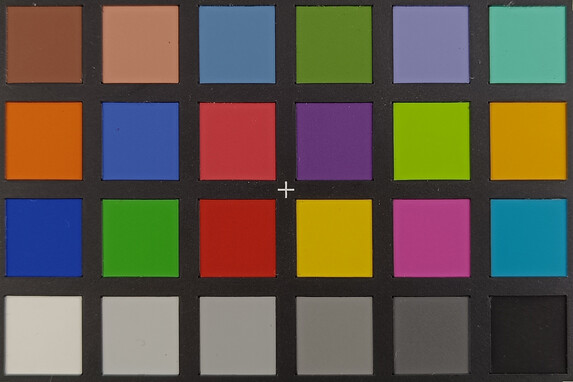
6.6 ∆E
8.7 ∆E
3.7 ∆E
11.1 ∆E
3.9 ∆E
4.2 ∆E
9.7 ∆E
4.5 ∆E
10 ∆E
3.9 ∆E
6.1 ∆E
6.5 ∆E
3 ∆E
6.6 ∆E
8.9 ∆E
10.7 ∆E
7.1 ∆E
1.1 ∆E
12.5 ∆E
10.6 ∆E
5.6 ∆E
4.4 ∆E
2.4 ∆E
5.7 ∆E
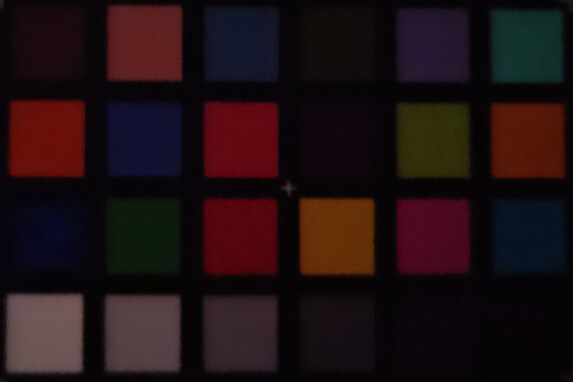
26 ∆E
41.5 ∆E
34.3 ∆E
34.1 ∆E
37 ∆E
50.8 ∆E
38.8 ∆E
26.4 ∆E
26.1 ∆E
25.6 ∆E
52.7 ∆E
54.6 ∆E
23.6 ∆E
40.6 ∆E
19.6 ∆E
57.2 ∆E
31.9 ∆E
38.1 ∆E
46.7 ∆E
49.1 ∆E
45.2 ∆E
35.3 ∆E
23.5 ∆E
13.5 ∆E

The box of the Note 12 Pro includes a protective cover, USB-C cable, quick-start guide, and SIM toolkit, and fortunately, a corresponding 67-Watt Turbo Charging charger is also included with the midrange smartphone.
There is only a one-year limited standard warranty for the Redmi smartphone in Germany. However, the required manufacturer warranty of 24 months for new devices in Germany remains unaffected by this.
The AMOLED panel with a refresh rate of 120 Hz makes animations and scrolling websites appear very smooth. The capacitive touchscreen with a scan rate of up to 240 Hz recognizes inputs quickly and accurately. In the state of delivery, the manufacturer has installed a protective foil that is less prone to show greasy smudges. The vibration motor of the Redmi Note 12 Pro is very attractive and accurate for a midrange smartphone.
A fingerprint sensor hidden in the power button provides biometric security. The positioning in the Redmi Note 12 Pro feels very comfortable and makes it easily accessible. The active sensor responds swiftly, delivering good recognition rates. In good light conditions, the unlocking process works even faster using face recognition via the front camera. However, the 2D process that is used here is less secure.
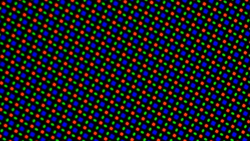
Like the Note 11 Pro before, its midrange successor has a large 6.67-inch AMOLED display that offers a 2,400 x 1,080 pixel resolution and supports a refresh rate of 120 Hz. Even though the Redmi phone doesn’t use an LTPO panel that is able to deliver variable frequencies, the Note 12 Pro is able to switch the frequency between 60 and 120 Hz automatically. However, currently this function still appears to be limited to some specific applications, since the Note 12 Pro still stays at 120 Hz even after five minutes of showing the home screen. When starting some selected apps such as YouTube for example, the display then switches to the 60-Hz mode. Some software refinements are still needed in this regard.
The Chinese manufacturer specifies the maximum panel brightness as 900 cd/m², which almost exactly corresponds to our measured values with the brightness sensor activated showing a pure white display. When adding dark areas in the APL 18, the Redmi smartphone reaches a very similar 953 cd/m² in the center of the display. With this, the DolbyVision certified OLED panel is also suited for the reproduction of HDR contents.
Due to the display technology that is used here, the Redmi Note 12 Pro is not spared from display flickering. In our measurements, the PWM frequency hardly varies, remaining at a relatively constant 120 Hz. However, Xiaomi itself mentions a very high PWM frequency (1,920 Hz), which should be much more comfortable particularly for sensitive users. We are unable to come to a final determination whether the reason for this discrepancy lies within our measurement equipment or whether this automatic mode resembling DC dimming was simply not activated during our test.
| 921 cd/m² |
933 cd/m² |
958 cd/m² |
||
| 921 cd/m² |
938 cd/m² |
963 cd/m² |
||
| 921 cd/m² |
935 cd/m² |
958 cd/m² |
||
Distribution of brightness
X-Rite i1Pro 3
Maximum: 963 cd/m² (Nits) Average: 938.7 cd/m² Minimum: 2.29 cd/m²
Brightness Distribution: 96 %
Center on Battery: 938 cd/m²
Contrast: ∞:1 (Black: 0 cd/m²)
ΔE Color 0.9 | 0.55-29.43 Ø5.2
ΔE Greyscale 1 | 0.57-98 Ø5.4
98.9% sRGB (Calman 2D)
Gamma: 2.25
| Xiaomi Redmi Note 12 Pro 5G OLED, 2400×1080, 6.67 |
Xiaomi Redmi Note 11 Pro 5G AMOLED, 2400×1080, 6.67 |
Motorola Edge 30 Neo pOLED, 2400×1080, 6.30 |
Samsung Galaxy A53 AMOLED, 2400×1080, 6.50 |
Xiaomi Poco F4 AMOLED, 2400×1080, 6.67 |
|
|---|---|---|---|---|---|
| Screen |
-52% |
-67% |
-65% |
-100% |
|
| Brightness middle |
938 |
675 -28% |
984 5% |
718 -23% |
917 -2% |
| Brightness |
939 |
686 -27% |
992 6% |
730 -22% |
923 -2% |
| Brightness Distribution |
96 |
95 -1% |
98 2% |
92 -4% |
96 0% |
| Black Level * | |||||
| Colorchecker dE 2000 * |
0.9 |
1.3 -44% |
1.6 -78% |
1.62 -80% |
2 -122% |
| Colorchecker dE 2000 max. * |
1.6 |
3.9 -144% |
3.8 -138% |
4.21 -163% |
5.2 -225% |
| Greyscale dE 2000 * |
1 |
1.7 -70% |
3 -200% |
2 -100% |
3.5 -250% |
| Gamma |
2.25 98% |
2.16 102% |
2.14 103% |
2.156 102% |
2.23 99% |
| CCT |
6350 102% |
6591 99% |
6518 100% |
6545 99% |
6447 101% |
* … smaller is better
Screen Flickering / PWM (Pulse-Width Modulation)
ℹ
To dim the screen, some notebooks will simply cycle the backlight on and off in rapid succession – a method called Pulse Width Modulation (PWM) . This cycling frequency should ideally be undetectable to the human eye. If said frequency is too low, users with sensitive eyes may experience strain or headaches or even notice the flickering altogether.
| Screen flickering / PWM detected | 120 Hz |
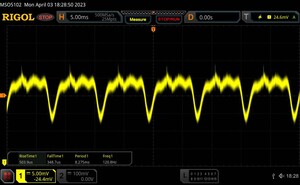 |
|
|
The display backlight flickers at 120 Hz (Likely utilizing PWM) . The frequency of 120 Hz is very low, so the flickering may cause eyestrain and headaches after extended use. In comparison: 53 % of all tested devices do not use PWM to dim the display. If PWM was detected, an average of 19014 (minimum: 2.4 – maximum: 3846000) Hz was measured. |
|||
Series of measurements at a fixed zoom level with various brightness settings
We evaluate the color reproduction of the display using a photo spectrometer and the Calman analysis software. In the default “Standard” color profile, the Redmi Note 12 Pro offers a very accurate adjustment. If any, the differences to the targeted sRGB color space are only noticeable with the Magenta color. Xiaomi specifies a complete coverage of the DCI-P3 color space for the OLED panel.
In terms of adjustment options, in addition to the three different color profiles, the MIUI 14 user interface also offers an individual mode. This allows you to adjust the color temperature to your personal likings, and you can also define some individual display parameters such as the saturation or Gamma, as well as the targeted color space (P3, sRGB).
Display Response Times
ℹ
Display response times show how fast the screen is able to change from one color to the next. Slow response times can lead to afterimages and can cause moving objects to appear blurry (ghosting). Gamers of fast-paced 3D titles should pay special attention to fast response times.
| ↔ Response Time Black to White | ||
|---|---|---|
| 1.26 ms … rise ↗ and fall ↘ combined | ↗ 0.624 ms rise |
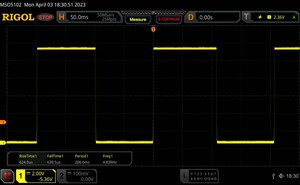 |
| ↘ 0.6365 ms fall | ||
| The screen shows very fast response rates in our tests and should be very well suited for fast-paced gaming. In comparison, all tested devices range from 0.4 (minimum) to 240 (maximum) ms. » 2 % of all devices are better. This means that the measured response time is better than the average of all tested devices (22.5 ms). |
||
| ↔ Response Time 50% Grey to 80% Grey | ||
| 1.44 ms … rise ↗ and fall ↘ combined | ↗ 0.684 ms rise |
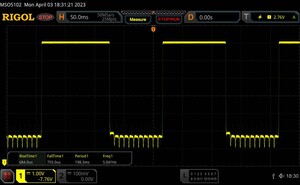 |
| ↘ 0.755 ms fall | ||
| The screen shows very fast response rates in our tests and should be very well suited for fast-paced gaming. In comparison, all tested devices range from 0.25 (minimum) to 636 (maximum) ms. » 2 % of all devices are better. This means that the measured response time is better than the average of all tested devices (35.5 ms). |
||
Outdoors, the display of the midrange smartphone can be read easily, even if you cannot expect the brightness reserves of a Xiaomi 13 Pro here. Even on sunny days, the Redmi 12 Pro strikes a good figure, but some pronounced reflections can become a hindrance here. Those who make do without automatic brightness adjustment have to be content with 512 cd/m².
The viewing angle stability of the AMOLED display is very good. Even from very steep viewing angles, there are hardly any annoying color changes, and the brightness also decreases only slightly.

The Redmi Note 12 Pro uses the successor of the Dimensity 920, which is also manufactured with a structure width of 6 nanometers in the N6 process. The MediaTek Dimensity 1080 is based on two powerful ARM Cortex A78 computing cores that are accompanied by six efficient Cortex A55 cores.
In our CPU benchmark package, the Redmi Note 12 Pro delivers good results, but a Poco F4 with the Qualcomm Snapdragon 870 is almost one third faster in Geekbench. Surprisingly, a realme 9 Pro Plus with the MediaTek Dimensity 920 even places slightly ahead of the Redmi Note 12 Pro.
| Geekbench 5.4 | |
| Single-Core | |
| Xiaomi Poco F4 Qualcomm Snapdragon 870 5G, Adreno 650, 6144 |
|
| realme 9 Pro Plus MediaTek Dimensity 920, Mali-G68 MP4, 6144 |
|
| Average of class Smartphone (119 – 1885, n=250, last 2 years) |
|
| Average MediaTek Dimensity 1080 (765 – 782, n=2) |
|
| Xiaomi Redmi Note 12 Pro 5G MediaTek Dimensity 1080, Mali-G68 MP4, 8192 |
|
| Samsung Galaxy A53 Samsung Exynos 1280, Mali-G68 MP4, 6144 |
|
| Xiaomi Redmi Note 11 Pro 5G Qualcomm Snapdragon 695 5G, Adreno 619, 6144 |
|
| Motorola Edge 30 Neo Qualcomm Snapdragon 695 5G, Adreno 619, 8192 |
|
| Multi-Core | |
| Xiaomi Poco F4 Qualcomm Snapdragon 870 5G, Adreno 650, 6144 |
|
| Average of class Smartphone (472 – 5538, n=250, last 2 years) |
|
| Average MediaTek Dimensity 1080 (2035 – 2315, n=2) |
|
| realme 9 Pro Plus MediaTek Dimensity 920, Mali-G68 MP4, 6144 |
|
| Xiaomi Redmi Note 12 Pro 5G MediaTek Dimensity 1080, Mali-G68 MP4, 8192 |
|
| Motorola Edge 30 Neo Qualcomm Snapdragon 695 5G, Adreno 619, 8192 |
|
| Xiaomi Redmi Note 11 Pro 5G Qualcomm Snapdragon 695 5G, Adreno 619, 6144 |
|
| Samsung Galaxy A53 Samsung Exynos 1280, Mali-G68 MP4, 6144 |
|
| Geekbench 6 | |
| Single-Core | |
| Average of class Smartphone (188 – 2531, n=29, last 2 years) |
|
| Average MediaTek Dimensity 1080 (968 – 1029, n=2) |
|
| Xiaomi Redmi Note 12 Pro 5G MediaTek Dimensity 1080, Mali-G68 MP4, 8192 |
|
| Multi-Core | |
| Average of class Smartphone (512 – 6460, n=29, last 2 years) |
|
| Average MediaTek Dimensity 1080 (2201 – 2497, n=2) |
|
| Xiaomi Redmi Note 12 Pro 5G MediaTek Dimensity 1080, Mali-G68 MP4, 8192 |
|
| PCMark for Android – Work 3.0 | |
| Xiaomi Poco F4 Qualcomm Snapdragon 870 5G, Adreno 650, 6144 |
|
| Xiaomi Redmi Note 12 Pro 5G MediaTek Dimensity 1080, Mali-G68 MP4, 8192 |
|
| Average MediaTek Dimensity 1080 (11721 – 11763, n=2) |
|
| Samsung Galaxy A53 Samsung Exynos 1280, Mali-G68 MP4, 6144 |
|
| realme 9 Pro Plus MediaTek Dimensity 920, Mali-G68 MP4, 6144 |
|
| Average of class Smartphone (4436 – 19783, n=231, last 2 years) |
|
| Xiaomi Redmi Note 11 Pro 5G Qualcomm Snapdragon 695 5G, Adreno 619, 6144 |
|
| Motorola Edge 30 Neo Qualcomm Snapdragon 695 5G, Adreno 619, 8192 |
|
| CrossMark – Overall | |
| Average of class Smartphone (226 – 1332, n=115, last 2 years) |
|
| Xiaomi Poco F4 Qualcomm Snapdragon 870 5G, Adreno 650, 6144 |
|
| Xiaomi Redmi Note 12 Pro 5G MediaTek Dimensity 1080, Mali-G68 MP4, 8192 |
|
| Average MediaTek Dimensity 1080 (657 – 665, n=2) |
|
| Xiaomi Redmi Note 11 Pro 5G Qualcomm Snapdragon 695 5G, Adreno 619, 6144 |
|
| Samsung Galaxy A53 Samsung Exynos 1280, Mali-G68 MP4, 6144 |
|
| Motorola Edge 30 Neo Qualcomm Snapdragon 695 5G, Adreno 619, 8192 |
|
| BaseMark OS II | |
| Overall | |
| Xiaomi Poco F4 Qualcomm Snapdragon 870 5G, Adreno 650, 6144 |
|
| Average of class Smartphone (411 – 9585, n=162, last 2 years) |
|
| Xiaomi Redmi Note 12 Pro 5G MediaTek Dimensity 1080, Mali-G68 MP4, 8192 |
|
| Average MediaTek Dimensity 1080 (3850 – 4189, n=2) |
|
| Motorola Edge 30 Neo Qualcomm Snapdragon 695 5G, Adreno 619, 8192 |
|
| Xiaomi Redmi Note 11 Pro 5G Qualcomm Snapdragon 695 5G, Adreno 619, 6144 |
|
| Samsung Galaxy A53 Samsung Exynos 1280, Mali-G68 MP4, 6144 |
|
| System | |
| Xiaomi Poco F4 Qualcomm Snapdragon 870 5G, Adreno 650, 6144 |
|
| Average of class Smartphone (2083 – 19657, n=162, last 2 years) |
|
| Motorola Edge 30 Neo Qualcomm Snapdragon 695 5G, Adreno 619, 8192 |
|
| Xiaomi Redmi Note 11 Pro 5G Qualcomm Snapdragon 695 5G, Adreno 619, 6144 |
|
| Samsung Galaxy A53 Samsung Exynos 1280, Mali-G68 MP4, 6144 |
|
| Average MediaTek Dimensity 1080 (6684 – 7182, n=2) |
|
| Xiaomi Redmi Note 12 Pro 5G MediaTek Dimensity 1080, Mali-G68 MP4, 8192 |
|
| Memory | |
| Xiaomi Poco F4 Qualcomm Snapdragon 870 5G, Adreno 650, 6144 |
|
| Xiaomi Redmi Note 12 Pro 5G MediaTek Dimensity 1080, Mali-G68 MP4, 8192 |
|
| Average MediaTek Dimensity 1080 (5267 – 5938, n=2) |
|
| Average of class Smartphone (670 – 11617, n=162, last 2 years) |
|
| Motorola Edge 30 Neo Qualcomm Snapdragon 695 5G, Adreno 619, 8192 |
|
| Xiaomi Redmi Note 11 Pro 5G Qualcomm Snapdragon 695 5G, Adreno 619, 6144 |
|
| Samsung Galaxy A53 Samsung Exynos 1280, Mali-G68 MP4, 6144 |
|
| Graphics | |
| Xiaomi Poco F4 Qualcomm Snapdragon 870 5G, Adreno 650, 6144 |
|
| Average of class Smartphone (697 – 29649, n=162, last 2 years) |
|
| Samsung Galaxy A53 Samsung Exynos 1280, Mali-G68 MP4, 6144 |
|
| Xiaomi Redmi Note 12 Pro 5G MediaTek Dimensity 1080, Mali-G68 MP4, 8192 |
|
| Average MediaTek Dimensity 1080 (4666 – 5093, n=2) |
|
| Xiaomi Redmi Note 11 Pro 5G Qualcomm Snapdragon 695 5G, Adreno 619, 6144 |
|
| Motorola Edge 30 Neo Qualcomm Snapdragon 695 5G, Adreno 619, 8192 |
|
| Web | |
| Xiaomi Redmi Note 12 Pro 5G MediaTek Dimensity 1080, Mali-G68 MP4, 8192 |
|
| Average of class Smartphone (10 – 2392, n=162, last 2 years) |
|
| Average MediaTek Dimensity 1080 (1244 – 1521, n=2) |
|
| Motorola Edge 30 Neo Qualcomm Snapdragon 695 5G, Adreno 619, 8192 |
|
| Xiaomi Poco F4 Qualcomm Snapdragon 870 5G, Adreno 650, 6144 |
|
| Samsung Galaxy A53 Samsung Exynos 1280, Mali-G68 MP4, 6144 |
|
| Xiaomi Redmi Note 11 Pro 5G Qualcomm Snapdragon 695 5G, Adreno 619, 6144 |
|
| UL Procyon AI Inference – Overall Score | |
| Average of class Smartphone (207 – 84787, n=105, last 2 years) |
|
| Average MediaTek Dimensity 1080 (21997 – 22490, n=2) |
|
| Xiaomi Redmi Note 12 Pro 5G MediaTek Dimensity 1080, Mali-G68 MP4, 8192 |
|
| realme 9 Pro Plus MediaTek Dimensity 920, Mali-G68 MP4, 6144 |
|
| Xiaomi Poco F4 Qualcomm Snapdragon 870 5G, Adreno 650, 6144 |
|
| Xiaomi Redmi Note 11 Pro 5G Qualcomm Snapdragon 695 5G, Adreno 619, 6144 |
|
| Motorola Edge 30 Neo Qualcomm Snapdragon 695 5G, Adreno 619, 8192 |
|
| Samsung Galaxy A53 Samsung Exynos 1280, Mali-G68 MP4, 6144 |
|
Since the Dimensity 1080 continues to use the same Mali-G68 MP4 the Dimensity 920 already used as the graphics chip, it is not very surprising that the values of the Xiaomi Handy in GFXBench and 3DMark are at a similar level as those of a realme 9 Pro Plus. The performance differences to the Poco F4 with its Adreno 650 are even more pronounced than in the CPU benchmarks.
| 3DMark / Wild Life Extreme Unlimited | |
| Xiaomi Poco F4 Adreno 650, SD 870, 128 GB UFS 3.1 Flash |
|
| Xiaomi Redmi Note 12 Pro 5G Mali-G68 MP4, Dimensity 1080, 128 GB UFS 2.2 Flash |
|
| Samsung Galaxy A53 Mali-G68 MP4, Exynos 1280, 128 GB UFS 2.1 Flash |
|
| Motorola Edge 30 Neo Adreno 619, SD 695 5G, 128 GB UFS 2.2 Flash |
|
| Xiaomi Redmi Note 11 Pro 5G Adreno 619, SD 695 5G, 128 GB UFS 2.2 Flash |
|
| 3DMark / Wild Life Extreme | |
| Xiaomi Poco F4 Adreno 650, SD 870, 128 GB UFS 3.1 Flash |
|
| Xiaomi Redmi Note 12 Pro 5G Mali-G68 MP4, Dimensity 1080, 128 GB UFS 2.2 Flash |
|
| realme 9 Pro Plus Mali-G68 MP4, Dimensity 920, 128 GB UFS 2.2 Flash |
|
| Samsung Galaxy A53 Mali-G68 MP4, Exynos 1280, 128 GB UFS 2.1 Flash |
|
| Xiaomi Redmi Note 11 Pro 5G Adreno 619, SD 695 5G, 128 GB UFS 2.2 Flash |
|
| Motorola Edge 30 Neo Adreno 619, SD 695 5G, 128 GB UFS 2.2 Flash |
|
| 3DMark / Wild Life Unlimited Score | |
| Xiaomi Poco F4 Adreno 650, SD 870, 128 GB UFS 3.1 Flash |
|
| Xiaomi Redmi Note 12 Pro 5G Mali-G68 MP4, Dimensity 1080, 128 GB UFS 2.2 Flash |
|
| Samsung Galaxy A53 Mali-G68 MP4, Exynos 1280, 128 GB UFS 2.1 Flash |
|
| realme 9 Pro Plus Mali-G68 MP4, Dimensity 920, 128 GB UFS 2.2 Flash |
|
| Motorola Edge 30 Neo Adreno 619, SD 695 5G, 128 GB UFS 2.2 Flash |
|
| Xiaomi Redmi Note 11 Pro 5G Adreno 619, SD 695 5G, 128 GB UFS 2.2 Flash |
|
| 3DMark / Wild Life Score | |
| Xiaomi Poco F4 Adreno 650, SD 870, 128 GB UFS 3.1 Flash |
|
| realme 9 Pro Plus Mali-G68 MP4, Dimensity 920, 128 GB UFS 2.2 Flash |
|
| Samsung Galaxy A53 Mali-G68 MP4, Exynos 1280, 128 GB UFS 2.1 Flash |
|
| Xiaomi Redmi Note 12 Pro 5G Mali-G68 MP4, Dimensity 1080, 128 GB UFS 2.2 Flash |
|
| Xiaomi Redmi Note 11 Pro 5G Adreno 619, SD 695 5G, 128 GB UFS 2.2 Flash |
|
| Motorola Edge 30 Neo Adreno 619, SD 695 5G, 128 GB UFS 2.2 Flash |
|
| 3DMark / Sling Shot Extreme (Vulkan) Unlimited Physics | |
| realme 9 Pro Plus Mali-G68 MP4, Dimensity 920, 128 GB UFS 2.2 Flash |
|
| Xiaomi Redmi Note 12 Pro 5G Mali-G68 MP4, Dimensity 1080, 128 GB UFS 2.2 Flash |
|
| Motorola Edge 30 Neo Adreno 619, SD 695 5G, 128 GB UFS 2.2 Flash |
|
| Samsung Galaxy A53 Mali-G68 MP4, Exynos 1280, 128 GB UFS 2.1 Flash |
|
| Xiaomi Redmi Note 11 Pro 5G Adreno 619, SD 695 5G, 128 GB UFS 2.2 Flash |
|
| 3DMark / Sling Shot Extreme (Vulkan) Unlimited Graphics | |
| realme 9 Pro Plus Mali-G68 MP4, Dimensity 920, 128 GB UFS 2.2 Flash |
|
| Xiaomi Redmi Note 12 Pro 5G Mali-G68 MP4, Dimensity 1080, 128 GB UFS 2.2 Flash |
|
| Samsung Galaxy A53 Mali-G68 MP4, Exynos 1280, 128 GB UFS 2.1 Flash |
|
| Xiaomi Redmi Note 11 Pro 5G Adreno 619, SD 695 5G, 128 GB UFS 2.2 Flash |
|
| Motorola Edge 30 Neo Adreno 619, SD 695 5G, 128 GB UFS 2.2 Flash |
|
| 3DMark / Sling Shot Extreme (Vulkan) Unlimited | |
| realme 9 Pro Plus Mali-G68 MP4, Dimensity 920, 128 GB UFS 2.2 Flash |
|
| Xiaomi Redmi Note 12 Pro 5G Mali-G68 MP4, Dimensity 1080, 128 GB UFS 2.2 Flash |
|
| Samsung Galaxy A53 Mali-G68 MP4, Exynos 1280, 128 GB UFS 2.1 Flash |
|
| Xiaomi Redmi Note 11 Pro 5G Adreno 619, SD 695 5G, 128 GB UFS 2.2 Flash |
|
| Motorola Edge 30 Neo Adreno 619, SD 695 5G, 128 GB UFS 2.2 Flash |
|
| 3DMark / Sling Shot Extreme (ES 3.1) Unlimited Physics | |
| Xiaomi Redmi Note 12 Pro 5G Mali-G68 MP4, Dimensity 1080, 128 GB UFS 2.2 Flash |
|
| Xiaomi Poco F4 Adreno 650, SD 870, 128 GB UFS 3.1 Flash |
|
| realme 9 Pro Plus Mali-G68 MP4, Dimensity 920, 128 GB UFS 2.2 Flash |
|
| Xiaomi Redmi Note 11 Pro 5G Adreno 619, SD 695 5G, 128 GB UFS 2.2 Flash |
|
| Motorola Edge 30 Neo Adreno 619, SD 695 5G, 128 GB UFS 2.2 Flash |
|
| Samsung Galaxy A53 Mali-G68 MP4, Exynos 1280, 128 GB UFS 2.1 Flash |
|
| 3DMark / Sling Shot Extreme (ES 3.1) Unlimited Graphics | |
| Xiaomi Poco F4 Adreno 650, SD 870, 128 GB UFS 3.1 Flash |
|
| realme 9 Pro Plus Mali-G68 MP4, Dimensity 920, 128 GB UFS 2.2 Flash |
|
| Xiaomi Redmi Note 12 Pro 5G Mali-G68 MP4, Dimensity 1080, 128 GB UFS 2.2 Flash |
|
| Samsung Galaxy A53 Mali-G68 MP4, Exynos 1280, 128 GB UFS 2.1 Flash |
|
| Xiaomi Redmi Note 11 Pro 5G Adreno 619, SD 695 5G, 128 GB UFS 2.2 Flash |
|
| Motorola Edge 30 Neo Adreno 619, SD 695 5G, 128 GB UFS 2.2 Flash |
|
| 3DMark / Sling Shot Extreme (ES 3.1) Unlimited | |
| Xiaomi Poco F4 Adreno 650, SD 870, 128 GB UFS 3.1 Flash |
|
| Xiaomi Redmi Note 12 Pro 5G Mali-G68 MP4, Dimensity 1080, 128 GB UFS 2.2 Flash |
|
| realme 9 Pro Plus Mali-G68 MP4, Dimensity 920, 128 GB UFS 2.2 Flash |
|
| Samsung Galaxy A53 Mali-G68 MP4, Exynos 1280, 128 GB UFS 2.1 Flash |
|
| Xiaomi Redmi Note 11 Pro 5G Adreno 619, SD 695 5G, 128 GB UFS 2.2 Flash |
|
| Motorola Edge 30 Neo Adreno 619, SD 695 5G, 128 GB UFS 2.2 Flash |
|
| GFXBench (DX / GLBenchmark) 2.7 / T-Rex Onscreen | |
| Samsung Galaxy A53 Mali-G68 MP4, Exynos 1280, 128 GB UFS 2.1 Flash |
|
| Xiaomi Redmi Note 11 Pro 5G Adreno 619, SD 695 5G, 128 GB UFS 2.2 Flash |
|
| Xiaomi Redmi Note 12 Pro 5G Mali-G68 MP4, Dimensity 1080, 128 GB UFS 2.2 Flash |
|
| Xiaomi Poco F4 Adreno 650, SD 870, 128 GB UFS 3.1 Flash |
|
| realme 9 Pro Plus Mali-G68 MP4, Dimensity 920, 128 GB UFS 2.2 Flash |
|
| GFXBench (DX / GLBenchmark) 2.7 / T-Rex Offscreen | |
| Xiaomi Poco F4 Adreno 650, SD 870, 128 GB UFS 3.1 Flash |
|
| realme 9 Pro Plus Mali-G68 MP4, Dimensity 920, 128 GB UFS 2.2 Flash |
|
| Xiaomi Redmi Note 12 Pro 5G Mali-G68 MP4, Dimensity 1080, 128 GB UFS 2.2 Flash |
|
| Xiaomi Redmi Note 11 Pro 5G Adreno 619, SD 695 5G, 128 GB UFS 2.2 Flash |
|
| Samsung Galaxy A53 Mali-G68 MP4, Exynos 1280, 128 GB UFS 2.1 Flash |
|
| GFXBench 3.0 / Manhattan Onscreen OGL | |
| Xiaomi Poco F4 Adreno 650, SD 870, 128 GB UFS 3.1 Flash |
|
| Xiaomi Redmi Note 12 Pro 5G Mali-G68 MP4, Dimensity 1080, 128 GB UFS 2.2 Flash |
|
| realme 9 Pro Plus Mali-G68 MP4, Dimensity 920, 128 GB UFS 2.2 Flash |
|
| Samsung Galaxy A53 Mali-G68 MP4, Exynos 1280, 128 GB UFS 2.1 Flash |
|
| Xiaomi Redmi Note 11 Pro 5G Adreno 619, SD 695 5G, 128 GB UFS 2.2 Flash |
|
| Motorola Edge 30 Neo Adreno 619, SD 695 5G, 128 GB UFS 2.2 Flash |
|
| GFXBench 3.0 / 1080p Manhattan Offscreen | |
| Xiaomi Poco F4 Adreno 650, SD 870, 128 GB UFS 3.1 Flash |
|
| Xiaomi Redmi Note 12 Pro 5G Mali-G68 MP4, Dimensity 1080, 128 GB UFS 2.2 Flash |
|
| realme 9 Pro Plus Mali-G68 MP4, Dimensity 920, 128 GB UFS 2.2 Flash |
|
| Samsung Galaxy A53 Mali-G68 MP4, Exynos 1280, 128 GB UFS 2.1 Flash |
|
| Xiaomi Redmi Note 11 Pro 5G Adreno 619, SD 695 5G, 128 GB UFS 2.2 Flash |
|
| Motorola Edge 30 Neo Adreno 619, SD 695 5G, 128 GB UFS 2.2 Flash |
|
| GFXBench 3.1 / Manhattan ES 3.1 Onscreen | |
| Xiaomi Poco F4 Adreno 650, SD 870, 128 GB UFS 3.1 Flash |
|
| realme 9 Pro Plus Mali-G68 MP4, Dimensity 920, 128 GB UFS 2.2 Flash |
|
| Xiaomi Redmi Note 12 Pro 5G Mali-G68 MP4, Dimensity 1080, 128 GB UFS 2.2 Flash |
|
| Samsung Galaxy A53 Mali-G68 MP4, Exynos 1280, 128 GB UFS 2.1 Flash |
|
| Motorola Edge 30 Neo Adreno 619, SD 695 5G, 128 GB UFS 2.2 Flash |
|
| Xiaomi Redmi Note 11 Pro 5G Adreno 619, SD 695 5G, 128 GB UFS 2.2 Flash |
|
| GFXBench 3.1 / Manhattan ES 3.1 Offscreen | |
| Xiaomi Poco F4 Adreno 650, SD 870, 128 GB UFS 3.1 Flash |
|
| realme 9 Pro Plus Mali-G68 MP4, Dimensity 920, 128 GB UFS 2.2 Flash |
|
| Xiaomi Redmi Note 12 Pro 5G Mali-G68 MP4, Dimensity 1080, 128 GB UFS 2.2 Flash |
|
| Samsung Galaxy A53 Mali-G68 MP4, Exynos 1280, 128 GB UFS 2.1 Flash |
|
| Xiaomi Redmi Note 11 Pro 5G Adreno 619, SD 695 5G, 128 GB UFS 2.2 Flash |
|
| Motorola Edge 30 Neo Adreno 619, SD 695 5G, 128 GB UFS 2.2 Flash |
|
| GFXBench / Car Chase Onscreen | |
| Xiaomi Poco F4 Adreno 650, SD 870, 128 GB UFS 3.1 Flash |
|
| realme 9 Pro Plus Mali-G68 MP4, Dimensity 920, 128 GB UFS 2.2 Flash |
|
| Xiaomi Redmi Note 12 Pro 5G Mali-G68 MP4, Dimensity 1080, 128 GB UFS 2.2 Flash |
|
| Samsung Galaxy A53 Mali-G68 MP4, Exynos 1280, 128 GB UFS 2.1 Flash |
|
| Xiaomi Redmi Note 11 Pro 5G Adreno 619, SD 695 5G, 128 GB UFS 2.2 Flash |
|
| Motorola Edge 30 Neo Adreno 619, SD 695 5G, 128 GB UFS 2.2 Flash |
|
| GFXBench / Car Chase Offscreen | |
| Xiaomi Poco F4 Adreno 650, SD 870, 128 GB UFS 3.1 Flash |
|
| realme 9 Pro Plus Mali-G68 MP4, Dimensity 920, 128 GB UFS 2.2 Flash |
|
| Xiaomi Redmi Note 12 Pro 5G Mali-G68 MP4, Dimensity 1080, 128 GB UFS 2.2 Flash |
|
| Samsung Galaxy A53 Mali-G68 MP4, Exynos 1280, 128 GB UFS 2.1 Flash |
|
| Xiaomi Redmi Note 11 Pro 5G Adreno 619, SD 695 5G, 128 GB UFS 2.2 Flash |
|
| Motorola Edge 30 Neo Adreno 619, SD 695 5G, 128 GB UFS 2.2 Flash |
|
| GFXBench / Aztec Ruins High Tier Onscreen | |
| Xiaomi Poco F4 Adreno 650, SD 870, 128 GB UFS 3.1 Flash |
|
| realme 9 Pro Plus Mali-G68 MP4, Dimensity 920, 128 GB UFS 2.2 Flash |
|
| Samsung Galaxy A53 Mali-G68 MP4, Exynos 1280, 128 GB UFS 2.1 Flash |
|
| Xiaomi Redmi Note 12 Pro 5G Mali-G68 MP4, Dimensity 1080, 128 GB UFS 2.2 Flash |
|
| Xiaomi Redmi Note 11 Pro 5G Adreno 619, SD 695 5G, 128 GB UFS 2.2 Flash |
|
| Motorola Edge 30 Neo Adreno 619, SD 695 5G, 128 GB UFS 2.2 Flash |
|
| GFXBench / Aztec Ruins High Tier Offscreen | |
| Xiaomi Poco F4 Adreno 650, SD 870, 128 GB UFS 3.1 Flash |
|
| Xiaomi Redmi Note 12 Pro 5G Mali-G68 MP4, Dimensity 1080, 128 GB UFS 2.2 Flash |
|
| realme 9 Pro Plus Mali-G68 MP4, Dimensity 920, 128 GB UFS 2.2 Flash |
|
| Samsung Galaxy A53 Mali-G68 MP4, Exynos 1280, 128 GB UFS 2.1 Flash |
|
| Xiaomi Redmi Note 11 Pro 5G Adreno 619, SD 695 5G, 128 GB UFS 2.2 Flash |
|
| Motorola Edge 30 Neo Adreno 619, SD 695 5G, 128 GB UFS 2.2 Flash |
|
| GFXBench / Aztec Ruins Normal Tier Onscreen | |
| Xiaomi Poco F4 Adreno 650, SD 870, 128 GB UFS 3.1 Flash |
|
| realme 9 Pro Plus Mali-G68 MP4, Dimensity 920, 128 GB UFS 2.2 Flash |
|
| Xiaomi Redmi Note 12 Pro 5G Mali-G68 MP4, Dimensity 1080, 128 GB UFS 2.2 Flash |
|
| Samsung Galaxy A53 Mali-G68 MP4, Exynos 1280, 128 GB UFS 2.1 Flash |
|
| Motorola Edge 30 Neo Adreno 619, SD 695 5G, 128 GB UFS 2.2 Flash |
|
| Xiaomi Redmi Note 11 Pro 5G Adreno 619, SD 695 5G, 128 GB UFS 2.2 Flash |
|
| GFXBench / Aztec Ruins Normal Tier Offscreen | |
| Xiaomi Poco F4 Adreno 650, SD 870, 128 GB UFS 3.1 Flash |
|
| realme 9 Pro Plus Mali-G68 MP4, Dimensity 920, 128 GB UFS 2.2 Flash |
|
| Xiaomi Redmi Note 12 Pro 5G Mali-G68 MP4, Dimensity 1080, 128 GB UFS 2.2 Flash |
|
| Samsung Galaxy A53 Mali-G68 MP4, Exynos 1280, 128 GB UFS 2.1 Flash |
|
| Xiaomi Redmi Note 11 Pro 5G Adreno 619, SD 695 5G, 128 GB UFS 2.2 Flash |
|
| Motorola Edge 30 Neo Adreno 619, SD 695 5G, 128 GB UFS 2.2 Flash |
|
When surfing the Internet, the Redmi Phone impresses with fairly short load times and a smooth operation experience. The Note 12 Pro also does fairly well in the benchmark test.
| Jetstream 2 – Total Score | |
| Xiaomi Poco F4 (Edge 105) |
|
| Average of class Smartphone (16.9 – 282, n=164, last 2 years) |
|
| Motorola Edge 30 Neo (Chrome 106) |
|
| Xiaomi Redmi Note 12 Pro 5G (Chrome 111) |
|
| Average MediaTek Dimensity 1080 (69.7 – 71.9, n=2) |
|
| Xiaomi Redmi Note 11 Pro 5G (Mi Browser V13.10.0-gn) |
|
| Samsung Galaxy A53 (Chrome 101) |
|
| Speedometer 2.0 – Result | |
| Average of class Smartphone (13.3 – 375, n=151, last 2 years) |
|
| Xiaomi Redmi Note 12 Pro 5G (Chrome 111) |
|
| Average MediaTek Dimensity 1080 (62.2 – 62.9, n=2) |
|
| Xiaomi Poco F4 (Edge 105) |
|
| Samsung Galaxy A53 (Chome 101) |
|
| Xiaomi Redmi Note 11 Pro 5G (Mi Browser V13.10.0-gn) |
|
| WebXPRT 4 – Overall Score | |
| Average of class Smartphone (25 – 202, n=74, last 2 years) |
|
| Motorola Edge 30 Neo (chrome 106) |
|
| Average MediaTek Dimensity 1080 (71 – 74, n=2) |
|
| Xiaomi Redmi Note 12 Pro 5G (Chrome 111) |
|
| Xiaomi Redmi Note 11 Pro 5G (Chrome 103.0.5060.129) |
|
| Xiaomi Poco F4 (Chrome 103) |
|
| WebXPRT 3 – — | |
| Average of class Smartphone (28 – 292, n=149, last 2 years) |
|
| Average MediaTek Dimensity 1080 (102 – 114, n=2) |
|
| Xiaomi Poco F4 (chrome 103) |
|
| Xiaomi Redmi Note 12 Pro 5G (Chrome 111) |
|
| Xiaomi Redmi Note 11 Pro 5G (Mi Browser V13.10.0-gn) |
|
| Samsung Galaxy A53 (Chrome 101) |
|
| Octane V2 – Total Score | |
| Xiaomi Poco F4 (Edge 105) |
|
| Xiaomi Redmi Note 12 Pro 5G (Chrome 111) |
|
| Average of class Smartphone (4633 – 74261, n=192, last 2 years) |
|
| Average MediaTek Dimensity 1080 (25154 – 31662, n=2) |
|
| Motorola Edge 30 Neo (chrome 106) |
|
| Samsung Galaxy A53 (Chrome 101) |
|
| Xiaomi Redmi Note 11 Pro 5G (Mi Browser V13.10.0-gn) |
|
| Mozilla Kraken 1.1 – Total Score | |
| Average of class Smartphone (414 – 10797, n=168, last 2 years) |
|
| Xiaomi Redmi Note 11 Pro 5G (Mi Browser V13.10.0-gn) |
|
| Samsung Galaxy A53 (Chrome 101) |
|
| Xiaomi Poco F4 (chrome 103) |
|
| Average MediaTek Dimensity 1080 (1766 – 1797, n=2) |
|
| Xiaomi Redmi Note 12 Pro 5G (Chrome 111) |
|
| Motorola Edge 30 Neo (chrome 106) |
|
* … smaller is better
In terms of the storage connection, it becomes noticeable that the Note 12 Pro was already introduced last year in the Chinese market. The Xiaomi smartphone uses UFS 2.2 and LPDDR4 RAM here, which is okay considering the competitors. The UFS storage in the Xiaomi smartphone delivers a very high speed for the storage type.
| Xiaomi Redmi Note 12 Pro 5G | Xiaomi Redmi Note 11 Pro 5G | Motorola Edge 30 Neo | Samsung Galaxy A53 | Xiaomi Poco F4 | Average 128 GB UFS 2.2 Flash | Average of class Smartphone | |
|---|---|---|---|---|---|---|---|
| AndroBench 3-5 |
-31% |
-38% |
-27% |
-5% |
-30% |
-11% |
|
| Sequential Read 256KB |
1008.8 |
523 -48% |
498.82 -51% |
510.1 -49% |
1371.56 36% |
730 {el.classList.toggle(‘hideEl’);});return false;”>?(303 – 1009, n=41) -28% |
1111 {el.classList.toggle(‘hideEl’);});return false;”>?(90.5 – 3867, n=242, last 2 years) 10% |
| Sequential Write 256KB |
865.59 |
488.91 -44% |
469.52 -46% |
486.7 -44% |
701.06 -19% |
507 {el.classList.toggle(‘hideEl’);});return false;”>?(105.3 – 884, n=41) -41% |
678 {el.classList.toggle(‘hideEl’);});return false;”>?(13.6 – 3062, n=242, last 2 years) -22% |
| Random Read 4KB |
241.83 |
204.3 -16% |
180.19 -25% |
229.9 -5% |
183.61 -24% |
179.1 {el.classList.toggle(‘hideEl’);});return false;”>?(89.3 – 253, n=41) -26% |
198.8 {el.classList.toggle(‘hideEl’);});return false;”>?(22.2 – 543, n=242, last 2 years) -18% |
| Random Write 4KB |
234.21 |
196.38 -16% |
169.19 -28% |
210.8 -10% |
200.41 -14% |
178.3 {el.classList.toggle(‘hideEl’);});return false;”>?(113.8 – 258, n=41) -24% |
205 {el.classList.toggle(‘hideEl’);});return false;”>?(13 – 572, n=243, last 2 years) -12% |
Although the Mali-G68 MP4 used here, which is based on the Valhall architecture, is already a little older, its graphics performance should still be sufficient for HFR gaming – at least with older games. We evaluate the graphics performance with the tool from our partner GameBench.
Our first test game, PUBG Mobile, can only be played at medium detail settings (HD) – you cannot select an UHD setting with the Note 12 Pro – but the Shooter is reproduced at a very constant 40 fps. At the lowest detail level, it even reaches 60 fps. Asphalt 9 Legends is also reproduced very evenly at 30 fps, without any drops in the frame rate.
Armajet is limited to 120 fps, which is not surprising, since the native refresh rate of the Xiaomi smartphone is only 120 Hz. What is surprising is the fact that the arena shooter is reproduced at more than 100 fps without any larger fluctuations. Such constancy at a high level is even lacking in some current high-end smartphones.
Xiaomi advertises the Redmi Note 12 Pro with a 12-layer graphite plate cooling system that ensures comfortable surface temperatures in everyday operation. Even under constant load, the Redmi smartphone only becomes hand warm.
There is also no real heat development inside the case, which ensures a high performance constancy in the MediaTek SoC. The two stress tests of 3DMark don’t reveal any thermally induced throttling of the Dimensity 1080. The smartphone finishes the benchmarks at about 99%. We can therefore also almost rule out any pronounced reduction of the frame rates in everyday operation with constant high demands from some applications.
|
|||||||||||||||||||||||||
| Maximum: 32.9 °C=91 F Average: 31.6 °C=89 F |
|||||||||||||||||||||||||
|
|||||||||||||||||||||||||
| Maximum: 32 °C=90 F Average: 29.9 °C=86 F |
|||||||||||||||||||||||||
Power Supply (max.) 26.2 °C=79 F | Room Temperature 20.9 °C=70 F | Fluke t3000FC (calibrated) & Voltcraft IR-260
(+) The average temperature for the upper side under maximal load is 31.6 °C / 89 F, compared to the average of 32.6 °C / 91 F for the devices in the class Smartphone.
(+) The maximum temperature on the upper side is 32.9 °C / 91 F, compared to the average of 34.9 °C / 95 F, ranging from 21.9 to 52.9 °C for the class Smartphone.
(+) The bottom heats up to a maximum of 32 °C / 90 F, compared to the average of 33.7 °C / 93 F
(+) In idle usage, the average temperature for the upper side is 29 °C / 84 F, compared to the device average of 32.6 °C / 91 F.
| 3DMark | |
| Wild Life Stress Test Stability | |
| Samsung Galaxy A53 Mali-G68 MP4, Exynos 1280, 128 GB UFS 2.1 Flash |
|
| Motorola Edge 30 Neo Adreno 619, SD 695 5G, 128 GB UFS 2.2 Flash |
|
| Motorola Edge 30 Neo Adreno 619, SD 695 5G, 128 GB UFS 2.2 Flash |
|
| Xiaomi Redmi Note 11 Pro 5G Adreno 619, SD 695 5G, 128 GB UFS 2.2 Flash |
|
| Xiaomi Redmi Note 12 Pro 5G Mali-G68 MP4, Dimensity 1080, 128 GB UFS 2.2 Flash |
|
| Xiaomi Poco F4 Adreno 650, SD 870, 128 GB UFS 3.1 Flash |
|
| Wild Life Extreme Stress Test | |
| Xiaomi Redmi Note 12 Pro 5G Mali-G68 MP4, Dimensity 1080, 128 GB UFS 2.2 Flash |
|
| Xiaomi Redmi Note 11 Pro 5G Adreno 619, SD 695 5G, 128 GB UFS 2.2 Flash |
|
| Motorola Edge 30 Neo Adreno 619, SD 695 5G, 128 GB UFS 2.2 Flash |
|
| Motorola Edge 30 Neo Adreno 619, SD 695 5G, 128 GB UFS 2.2 Flash |
|
| Samsung Galaxy A53 Mali-G68 MP4, Exynos 1280, 128 GB UFS 2.1 Flash |
|
| Xiaomi Poco F4 Adreno 650, SD 870, 128 GB UFS 3.1 Flash |
|
Xiaomi Redmi Note 12 Pro 5G Mali-G68 MP4, Dimensity 1080, 128 GB UFS 2.2 Flash; Wild Life Extreme Stress Test; 1.1.0.2: Ø3.79 (3.79-3.8)
Xiaomi Redmi Note 11 Pro 5G Adreno 619, SD 695 5G, 128 GB UFS 2.2 Flash; Wild Life Extreme Stress Test; 1.0.9.1: Ø2.16 (2.16-2.17)
Motorola Edge 30 Neo Adreno 619, SD 695 5G, 128 GB UFS 2.2 Flash; Wild Life Extreme Stress Test; 1.1.0.2: Ø2.15 (2.14-2.16)
Samsung Galaxy A53 Mali-G68 MP4, Exynos 1280, 128 GB UFS 2.1 Flash; Wild Life Extreme Stress Test; 1.0.9.1: Ø3.81 (3.75-3.84)
Xiaomi Poco F4 Adreno 650, SD 870, 128 GB UFS 3.1 Flash; Wild Life Extreme Stress Test; 1.0.9.1: Ø6.11 (6-6.84)
Xiaomi Redmi Note 12 Pro 5G Mali-G68 MP4, Dimensity 1080, 128 GB UFS 2.2 Flash; Wild Life Stress Test Stability; 0.0.0.0: Ø13.7 (13.6-13.7)
Xiaomi Redmi Note 11 Pro 5G Adreno 619, SD 695 5G, 128 GB UFS 2.2 Flash; Wild Life Stress Test Stability; 0.0.0.0: Ø7.23 (7.21-7.25)
Motorola Edge 30 Neo Adreno 619, SD 695 5G, 128 GB UFS 2.2 Flash; Wild Life Stress Test Stability; 0.0.0.0: Ø7.2 (7.19-7.22)
Samsung Galaxy A53 Mali-G68 MP4, Exynos 1280, 128 GB UFS 2.1 Flash; Wild Life Stress Test Stability; 0.0.0.0: Ø13.7 (13.7-13.7)
Xiaomi Poco F4 Adreno 650, SD 870, 128 GB UFS 3.1 Flash; Wild Life Stress Test Stability; 0.0.0.0: Ø21.9 (21.2-23.2)
The midrange smartphone from Xiaomi offers two speakers whose sound quality shows even mids and even a hint of bass. The highs are also balanced, although there is a pronounced drop in the super high frequencies.
Users of the Redmi Note 12 Pro also don’t have to live without a 3.5-mm audio port. But the sound from the audio port isn’t particularly clean or low in noise – we measure a signal-to-noise ratio of 69 dBFS. Those who prefer a wireless connection can use Bluetooth 5.2. In terms of the codecs, almost everything from aptX and aptX HD via AAC and LHDC up to LDAC is supported.
Frequency diagram (checkboxes can be checked and unchecked to compare devices)
Xiaomi Redmi Note 12 Pro 5G audio analysis
(+) | speakers can play relatively loud (89.2 dB)
Bass 100 – 315 Hz
(-) | nearly no bass – on average 30.2% lower than median
(±) | linearity of bass is average (7.5% delta to prev. frequency)
Mids 400 – 2000 Hz
(±) | reduced mids – on average 5.7% lower than median
(+) | mids are linear (5.6% delta to prev. frequency)
Highs 2 – 16 kHz
(+) | balanced highs – only 3.4% away from median
(+) | highs are linear (2.6% delta to prev. frequency)
Overall 100 – 16.000 Hz
(±) | linearity of overall sound is average (19% difference to median)
Compared to same class
» 18% of all tested devices in this class were better, 10% similar, 72% worse
» The best had a delta of 12%, average was 23%, worst was 65%
Compared to all devices tested
» 45% of all tested devices were better, 8% similar, 47% worse
» The best had a delta of 3%, average was 20%, worst was 65%
Samsung Galaxy A53 audio analysis
(+) | speakers can play relatively loud (86.1 dB)
Bass 100 – 315 Hz
(-) | nearly no bass – on average 25.7% lower than median
(±) | linearity of bass is average (11.2% delta to prev. frequency)
Mids 400 – 2000 Hz
(±) | higher mids – on average 8.4% higher than median
(±) | linearity of mids is average (7.1% delta to prev. frequency)
Highs 2 – 16 kHz
(±) | higher highs – on average 5.3% higher than median
(+) | highs are linear (6.7% delta to prev. frequency)
Overall 100 – 16.000 Hz
(±) | linearity of overall sound is average (24.1% difference to median)
Compared to same class
» 59% of all tested devices in this class were better, 12% similar, 30% worse
» The best had a delta of 12%, average was 23%, worst was 65%
Compared to all devices tested
» 75% of all tested devices were better, 7% similar, 18% worse
» The best had a delta of 3%, average was 20%, worst was 65%
The 5,000 mAh battery of the Redmi Note 12 Pro can be completely recharged from empty in about 45 minutes using the included 67-Watt charger. Wireless charging is not supported.
A low power consumption in idle operation is not one of the strengths of the Xiaomi smartphone. At more than 2 watts, the Note 12 Pro then consumes a relatively high amount of energy. On the other hand, the consumption is less pronounced under load conditions. The Xiaomi smartphone even shows itself relatively efficient in our GFXBench and Geekbench measurements.
| Xiaomi Redmi Note 12 Pro 5G 5000 mAh |
Xiaomi Redmi Note 11 Pro 5G 5000 mAh |
Motorola Edge 30 Neo 4020 mAh |
Samsung Galaxy A53 5000 mAh |
Xiaomi Poco F4 4500 mAh |
Average MediaTek Dimensity 1080 |
Average of class Smartphone |
|
|---|---|---|---|---|---|---|---|
| Power Consumption |
4% |
20% |
-0% |
16% |
6% |
5% |
|
| Idle Minimum * |
0.99 |
0.96 3% |
0.9 9% |
0.9 9% |
0.8 19% |
0.84 {el.classList.toggle(‘hideEl’);});return false;”>?(0.69 – 0.99, n=2) 15% |
0.88 {el.classList.toggle(‘hideEl’);});return false;”>?(0.12 – 2.5, n=176, last 2 years) 11% |
| Idle Average * |
2.03 |
2.31 -14% |
1.55 24% |
1.3 36% |
1.29 36% |
1.82 {el.classList.toggle(‘hideEl’);});return false;”>?(1.61 – 2.03, n=2) 10% |
1.517 {el.classList.toggle(‘hideEl’);});return false;”>?(0.65 – 3.6, n=176, last 2 years) 25% |
| Idle Maximum * |
2.08 |
2.34 -13% |
1.56 25% |
1.6 23% |
1.38 34% |
1.87 {el.classList.toggle(‘hideEl’);});return false;”>?(1.66 – 2.08, n=2) 10% |
1.719 {el.classList.toggle(‘hideEl’);});return false;”>?(0.69 – 3.7, n=176, last 2 years) 17% |
| Load Average * |
3.97 |
2.88 27% |
2.82 29% |
5.7 -44% |
3.78 5% |
3.99 {el.classList.toggle(‘hideEl’);});return false;”>?(3.97 – 4.01, n=2) -1% |
4.22 {el.classList.toggle(‘hideEl’);});return false;”>?(2.1 – 7.74, n=176, last 2 years) -6% |
| Load Maximum * |
5.85 |
4.88 17% |
4.97 15% |
7.3 -25% |
6.71 -15% |
6.18 {el.classList.toggle(‘hideEl’);});return false;”>?(5.85 – 6.5, n=2) -6% |
7 {el.classList.toggle(‘hideEl’);});return false;”>?(3.56 – 11.9, n=176, last 2 years) -20% |
* … smaller is better
In our video test at an adjusted brightness of 150 cd/m2, the midrange smartphone lasts almost 17.5 hours, which is as long as its predecessor. With our simulated web surfing, the Redmi Note 12 Pro also reaches a very good 16 hours.
Battery Runtime
| Idle (without WLAN, min brightness) | 26h 38min | |
| WiFi Websurfing | 16h 18min | |
| Big Buck Bunny H.264 1080p | 17h 23min | |
| Load (maximum brightness) | 4h 59min |
Pros
+ bright AMOLED panel
+ beautiful display (120 Hz, low color deviation)
+ quick charge function + charger
+ good equipment
+ attractive main camera with OIS
Cons
– update schedule
– slow USB standard
– lack of storage expansion
– only IP53 certified
– high-gloss surface
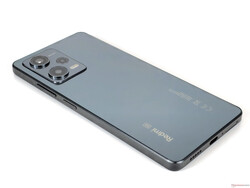
The Redmi Note 12 Pro is a successful upgrade of the Note 11 Pro, which we hadn’t necessarily expected just by looking at the data sheet. Although the main camera only offers a 50 MP resolution, the optically stabilized Sony image sensor turns it into a very good overall package for a midrange smartphone costing less than 400 Euros (~$440), particularly since you can finally record videos at UHD quality.
But the Redmi Note 12 Pro also has a lot to offer beyond the camera performance: fast Wi-Fi 6, a long battery life, a bright AMOLED panel with a 120 Hz refresh rate, low heat development, a solid SoC, and fast charging. We also want to mention another positive point, which is that Xiaomi included a corresponding 67-Watt charger in the box. Those who need more computing power in this price segment can take a look at a Poco F4 with the Qualcomm Snapdragon 870 – particularly since the Poco sibling model offers the faster storage standards with LPDDR5 and UFS 3.1.
The Note 12 Pro offers powerful technology in a midrange smartphone. But buyers of the Xiaomi smartphone have to weigh the positive points in the hardware against the short product cycle.
We have a complaint about the weak software support: buyers of a smartphone with an MSRP of 400 Euros should surely be able to expect more in the year 2023. Only two large Android update for an Android 12 device isn’t really up to the current standards anymore and not very environmentally sustainable either. Samsung shows how things can be done better with its Galaxy A34. Another unfortunate point is the removal of storage expansion, with only the “regular” Redmi Note 12 still offering this.
Xiaomi Redmi Note 12 Pro 5G
–
04/17/2023 v7
Marcus Herbrich
Connectivity
53 / 70 → 76%
Games Performance
46 / 64 → 72%
Application Performance
76 / 86 → 88%
Smartphone – Weighted Average
Transparency
The present review sample was made available to the author as a loan by the manufacturer or a shop for the purposes of review. The lender had no influence on this review, nor did the manufacturer receive a copy of this review before publication. There was no obligation to publish this review.
Pricecompare

I have always been very passionately interested in mobile technologies, especially smartphones. Being a tech enthusiast means the half-life of my devices isn’t exactly long, and being the latest hardware is not enough to suffice as the manufacturer and operating system play a minor role – the most important aspect for me is that the device is state-of-the-art. After posting for Mobi Test I joined Notebookcheck in 2016, where I have been pursuing my enthusiasm for technology by reviewing the latest smartphone, tablet, and accessory trends.

Translator: Mark Riege – Translator – 419 articles published on Notebookcheck since 2018
Having worked as a programmer for 20 years (medical devices, AI, data management systems), I’ve been following the computer scene for many years and especially enjoy finding out about new technology advances. Originally from Germany but living in the US, I’ve been working as a translator more recently, with Notebookcheck allowing me to combine my interest in new devices and translation. Other interests include Buddhism, spending time in Tibetan monasteries, and translating ancient Tibetan texts.
Marcus Herbrich, 2023-04-24 (Update: 2023-04-24)









